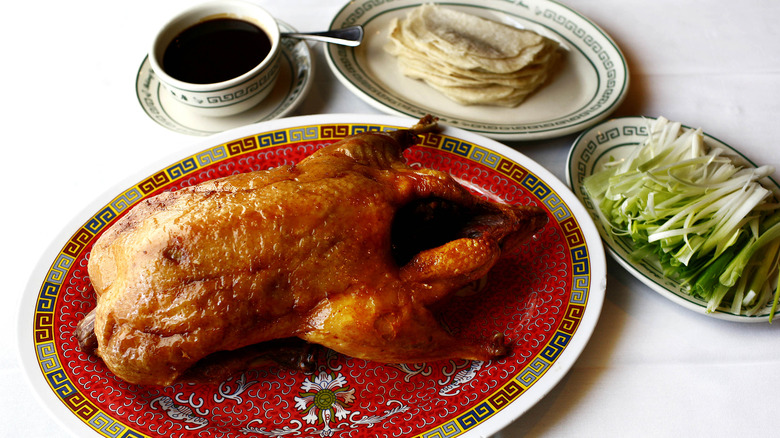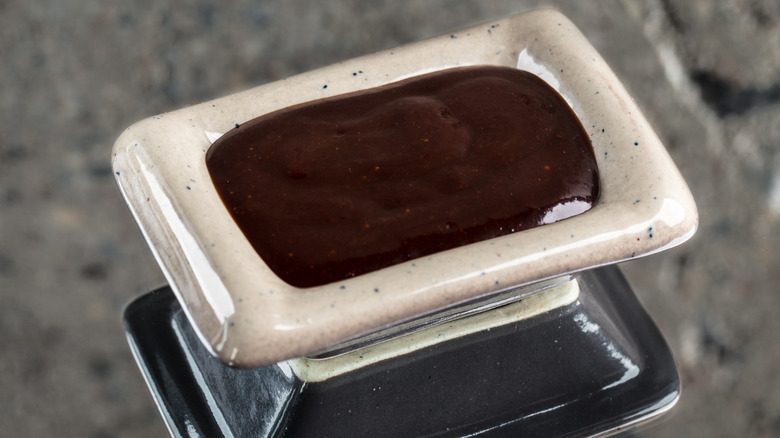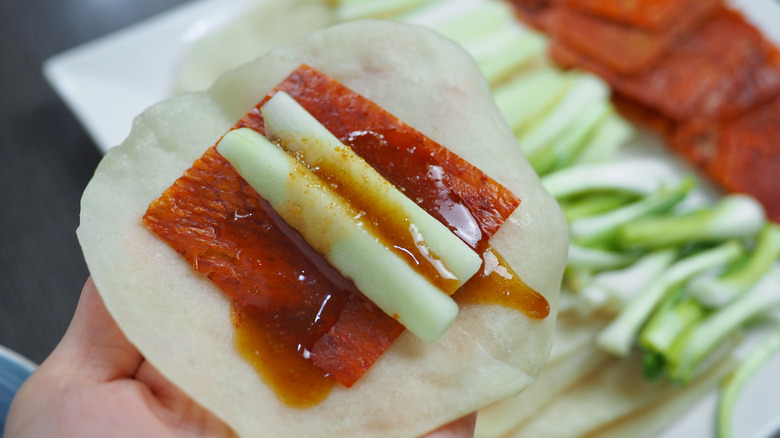What Is Hoisin Sauce And What Does It Taste Like?
A 1998 Washington Post story is titled "HOISIN MAKES ME HAPPY" — in all caps. Clearly, the sauce inspires an enthusiastic fandom, and for good reason.
Sometimes conflated with oyster, plum, or sweet bean sauce, hoisin sauce is a stalwart ingredient in Chinese cuisine, oftentimes associated with BBQ and dishes like Peking duck or moo shu pork, which involves slathering the savory sauce on crepe-like, gossamer "pancakes" and then wrapping them around sumptuous, roasted pork. Salty yet sweet, with a viscous, smooth, glossy essence, hoisin is essential to many classic dishes, and it pairs just as well with proteins such as beef and chicken as it does with vegetables, grains, and noodles. It is high in sugar, which helps any hoisin-glazed protein caramelize beautifully. Furthermore, its umami-forward flavor notes and consistency help to bolster the taste of almost anything it is added to. It is excellent in stir-fries, with fish, and is also delicious in lots of unexpected places; Bon Appétit actually notes that it's stellar on a hot dog.
Is hoisin good for you?
Of course, you can purchase bottles at most supermarkets, at Chinese markets, or you can make it yourself at home. Epicurious also has a recipe for a "hoisin sauce substitute," which can certainly come in handy if you're out of the jarred variation. This substitute contains an interesting mixture of soy, black bean paste or peanut butter, honey or molasses, white wine vinegar, garlic powder, sesame oil, and hot sauce. Clearly, the ingredients in hoisin depend entirely on the recipe develope, but no matter the specificity of the ingredients included, it's safe to say that it's always delicious, complex, and thick.
Spiceography acknowledges that hoisin offers B vitamins such as niacin and riboflavin, manganese, iron, and magnesium. Furthermore, it can help to prevent cancers and improve bone health. On the other hand, the sauce is rather high in both sodium and sugar, so it's definitely not a sauce that should be eaten by the spoonful, tempting though that might be.
What is the history of hoisin?
According to The Spruce Eats, "little is known" in regards to the history of hoisin; what's certain is that it is Cantonese in origin. Many sites state that Lee Kum Kee is one of the most — if not the single most — reputable brands of hoisin that is readily available. Britannica notes that hoisin is actually also sometimes called "Peking sauce," as it is used as an important ingredient in the cooking and serving of Peking duck. Serious Eats states that a little goes a long way — the thick, rich condiment can easily overtake more delicate ingredients, so be sure to use sparingly and in accordance with whatever you're serving it with.
High-quality hoisin is perfectly balanced. While the sweet flavor can easily overtake, it needs to be on par with the salt, the acidic, the savory, the tang, and the subtle spice. But when that happy medium is reached? Hoisin is unbeatable.


